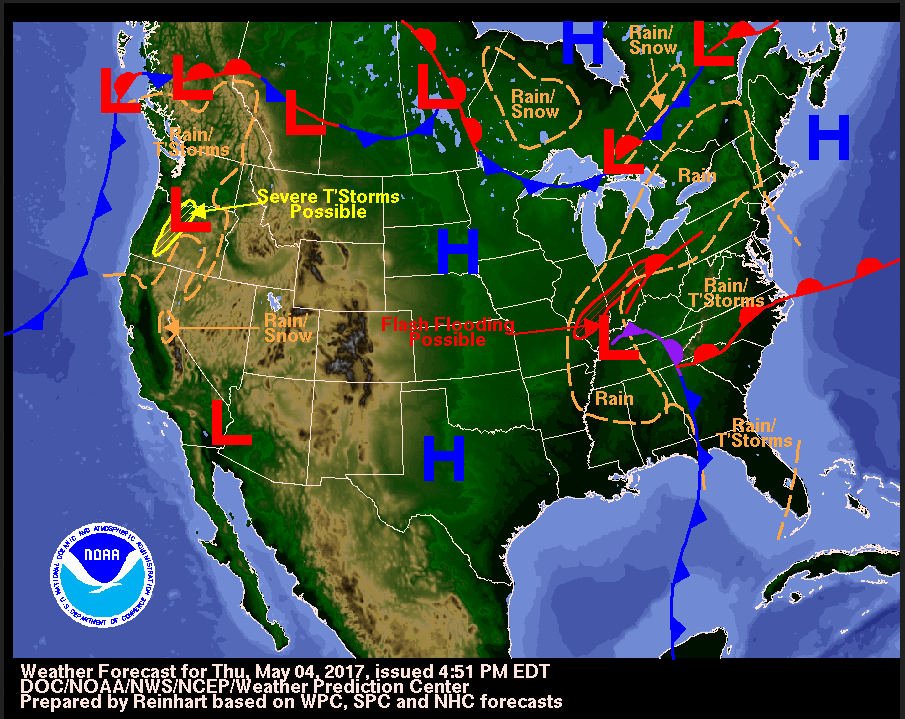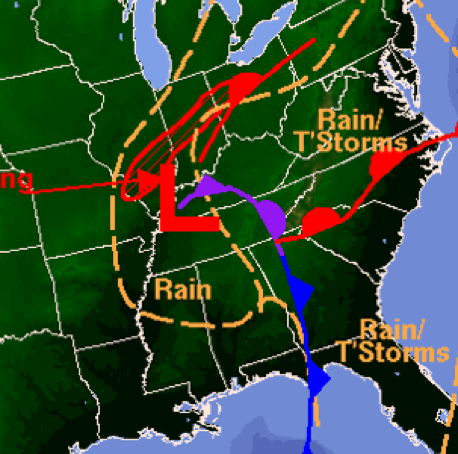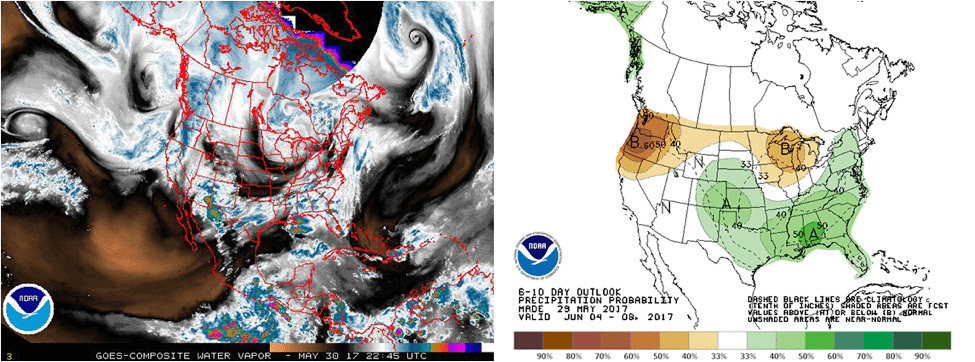What Do Blue Triangles on a Weather Map Mean
If you've looked at a weather forecast on your TV, computer or phone, you've probably seen a weather map that looks something like this:

Meteorologists at the National Weather Service use information from ground stations and weather satellites to make these maps. Words like "rain" and "snow" are pretty obvious, but what exactly do the symbols on a weather map tell you about the weather? Use our handy dandy guide below to find out!
High and Low Pressure Areas

Earth's atmosphere is a jacket of gases that surrounds the planet. Although it seems like these gases could easily float away into space, gravity is constantly pulling the atmosphere toward Earth's surface. The force with which our atmosphere pushes down on a specific location on Earth is called atmospheric pressure.
Atmospheric pressure is mainly dependent on two things: the weight of the atmosphere in a specific location and the temperature of the air. If you're at a low elevation—such as in a valley—there is a lot of atmosphere above you and the weight is very heavy. That means that you experience higher atmospheric pressure at lower elevations and lower atmospheric pressure in higher elevations.

When you're at a low elevation, you experience high atmospheric pressure because more of the atmosphere is pushing down on you.
Warm air can also cause the atmospheric pressure to rise. When the air is warm, gas molecules move around quickly in the air pushing out on the area around them. This causes high atmospheric pressure. In cold air the gas molecules slow down, causing low atmospheric pressure.
Water vapor in the atmosphere can also change the atmospheric pressure. Very moist air that has lots of water vapor is actually lighter and less dense than dry air. This is because water molecules are lighter than molecules of nitrogen or oxygen—the most abundant gases in our atmosphere. So, very moist air in the atmosphere can lead to low atmospheric pressure and very dry air can lead to high atmospheric pressure.
Atmospheric pressure is measured with an instrument on the ground called a barometer, and these measurements are collected at many locations across the U.S. by the National Weather Service. On weather maps, these readings are represented as a blue "H" for high pressure or a red "L" for low pressure.
What it Means on the Weather Map

Low pressure systems—like this one in the Tennessee valley—can cause the formation of clouds and storms.
A high pressure system is a dense air mass that is usually cooler and drier than the surrounding air. A low pressure system is a less dense air mass that is usually wetter and warmer than the surrounding air.
In general, areas that experience high atmospheric pressure also experience fair weather. Low pressure systems can cause the formation of clouds and storms. Air usually flows from areas of high pressure to areas of low pressure.
High and Low Pressure Systems: From Space
From high above Earth, satellites such as GOES-16 keep an eye on the weather brought by low pressure systems. The red "L" on the map above indicates a low pressure system in the Tennessee Valley region. In the video below from GOES-16, you can see what that same low pressure system looks like from a weather satellite.
Cold Fronts and Warm Fronts

A warm front is the transition area where a mass of warm air moves to replace a mass of cold air. On a weather map, a warm front is usually drawn using a solid red line with half circles pointing in the direction of the cold air that will be replaced. Warm fronts usually move from southwest to northeast. A warm front can initially bring some rain, followed by clear skies and warm temperatures.

A cold front is the transition area where a mass of cold air moves in to replace a mass of warm air. On a weather map, a cold front is usually drawn using a solid blue line with triangles pointing in the direction of the warm air that will be replaced. Cold fronts typically move from northwest to southeast. A cold front can bring cold temperatures, torrential rains and high wind speeds.

A stationary front happens when a cold front and a warm front meet up, but neither moves out of the way. On a weather map, a stationary front is usually drawn using alternating cold front and warm front symbols. Stationary fronts bring long rainy periods that stay in one spot.

Cold fronts move faster than warm fronts, and sometimes a cold front catches up to a warm front. When this happens, it's called an occluded front. Occluded fronts are drawn as a solid purple line with half circles and triangles pointing in the direction that the front is moving. An occluded front usually brings dry air.
Cold Fronts and Warm Fronts: From Space
GOES-16 and other weather satellites are also on the lookout for cold fronts and warm fronts and the weather they produce. Below, you can see the comparison of a cold front on a forecast map and a cold front in a satellite image.

On the left is a National Weather Service forecast map from March 24, 2017. The forecast map shows two cold fronts moving southeast over Texas. On the right is an actual GOES-16 image of atmospheric water vapor from the same afternoon.
Weather Satellites
Information from weather satellites, such as the GOES-R series and JPSS will help improve our understanding of Earth's weather.
For example, the GOES-R series provides information about atmospheric water vapor and cloud height right now. This can help meteorologists monitor and track severe weather events, such as storms and hurricanes as they happen. JPSS satellites survey the entire planet and continuously provide global atmospheric temperature and water vapor information. This information is needed to create reliable weather forecasts up to seven days in advance!

On the left is an image of water vapor captured by GOES satellites on May 30, 2017. GOES satellites, such as GOES-16, keep an eye on current weather. On the right is a forecast map predicting precipitation 6—10 days in advance. Polar orbiting satellites—such as JPSS—provide an outlook of weather events up to seven days in the future.
JPSS and the GOES-R series work together for weather applications. JPSS is critical for getting ready for severe weather events, while GOES-R monitors severe weather as it unfolds for real-time warnings.
Source: https://scijinks.gov/weather-map/
0 Response to "What Do Blue Triangles on a Weather Map Mean"
Post a Comment